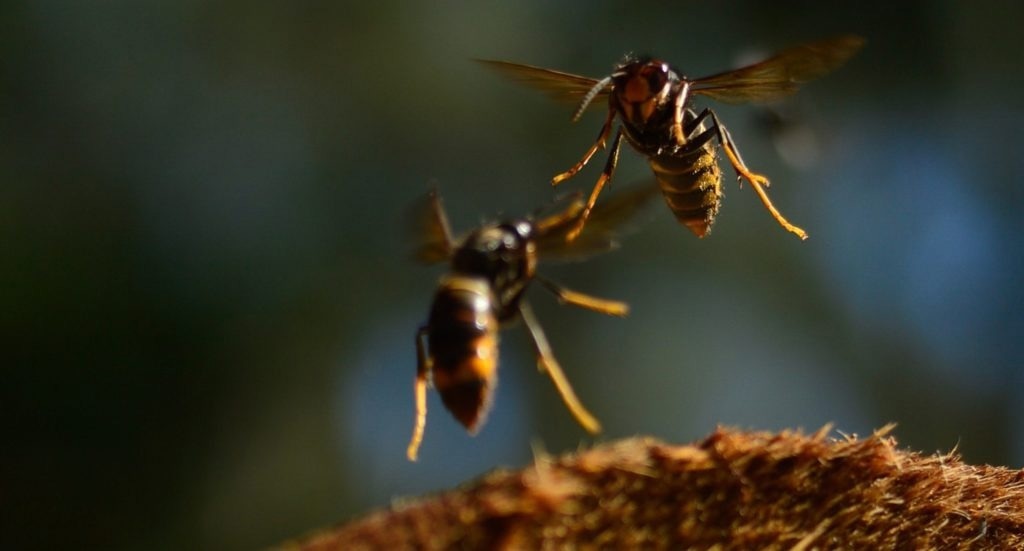Reviewed by Danielle Ellis, B.Sc.Oct 6 2023
New research reveals that bumblebees have developed a highly effective strategy to defend against Asian hornets.
 Asian hornets. Image Credit: Sandra Rojas-Nossa.
Asian hornets. Image Credit: Sandra Rojas-Nossa.
When under attack, buff-tailed bumblebees employ a unique tactic by dropping to the ground, thereby bringing the hornets down with them. This maneuver either forces the hornet to lose its grip or the bee raises its sting and engages in a struggle until the hornet retreats.
Scientists from the University of Exeter observed more than 120 of these confrontations and were amazed to find that the bumblebees successfully repelled the hornets in every instance.
However, it is important to note that the researchers observed a decrease in the growth rates of bumblebee colonies in regions with a high population of Asian hornets. This indicates that Asian hornets still have an adverse effect on bumblebee colonies, even when their attempts to breach the colony entrances are typically unsuccessful.
Asian hornets, also known as yellow-legged hornets, have already invaded significant parts of mainland Europe and some regions in East Asia.
Furthermore, they have recently been reported in the United States for the first time. Sightings of these hornets in the UK and continental Europe have reached record levels this year, raising concerns about their impact on pollinators and prompting substantial efforts to control their populations.
Asian hornets prey on a wide range of insects, including honey bees, but little is known about their impact on other pollinators. With honey bees, the hornets do something called ‘hawking’ – hovering outside the bees’ nest and attacking returning foragers as they fly past. We recorded hornets doing the same thing to bumblebees, but with the surprising difference that in our observations, they were entirely unsuccessful.”
Thomas O’Shea-Wheller, Environment and Sustainability Institute, Penryn Campus, University of Exeter
The study involved the placement of commercially reared bumblebee colonies at 12 different locations within the province of Pontevedra, Spain. These locations had varying levels of local Asian hornet populations.
The researchers monitored the colonies by regularly weighing them every two days, as changes in weight served as an indicator of colony growth. Notably, the colonies situated in areas with higher densities of Asian hornets exhibited slower rates of growth.
We can’t say for certain why this is. It’s possible that some external factor is good for Asian hornets, allowing them to thrive, but bad for bumblebees. However, it’s perhaps more likely that the presence of Asian hornets limits the success of bumblebee colonies. Although the attacks we witnessed at colony entrances were unsuccessful, bumblebees have been reported in the diet of Asian hornets, and the hornets are known to prey on them elsewhere.”
Thomas O’Shea-Wheller, Environment and Sustainability Institute, Penryn Campus, University of Exeter
Thomas O’Shea-Wheller adds, “Furthermore, defending against such attacks is likely energetically costly – and when hornet abundance is high, this could be a major problem for bees out foraging. Hornets also consume nectar from flowers, meaning they compete directly with bees for food and harass them at flower patches via constant attacks.”
I have seen hornets attack bumblebees of all sizes, including some that are larger than them. They are very persistent and generalist predators, so these attacks may still be worthwhile despite the high failure rate, as long as they sometimes get a kill.”
Thomas O’Shea-Wheller, Environment and Sustainability Institute, Penryn Campus, University of Exeter
Buff-tailed bumblebees (Bombus terrestris) have not coevolved with Asian hornets (Vespa velutina). Therefore, O'Shea-Wheller suggested that the bees' effective defense tactics might be a result of an "evolutionary coincidence."
“While honey bees are often unable to escape the clutches of Asian hornets once grappled in the air, the bumblebees’ defensive response of dropping to the ground appears to be more successful,” he adds.
Source:
Journal reference:
O’Shea-Wheller, T. A., et al. (2023). Quantifying the impact of an invasive Hornet on Bombus terrestris Colonies. Communications Biology. doi.org/10.1038/s42003-023-05329-5.